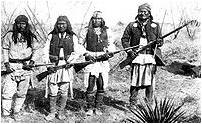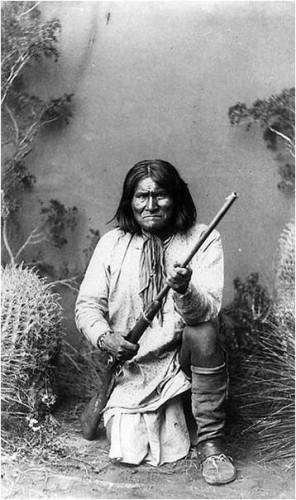Geronimo
(1829 – 1909)
Geronimo (in Chiricahua language Goyaałé, in other words ‘one who yawns’, in English often pronounced Goyathlay) (16th July 1829 – 17th February 1909) was the outstanding chieftain of the Chiricahua apache tribe living in the US, who fought a long battle against the European settlers occupying the tribe’s territory.
Geronimo was born at Turkey Creek, at the branch of river Gila, in the present-day New Mexico which belonged to Mexico and which was regarded as the territory of bedonkohe apache tribe. Geronimo himself came from this tribe as well. When he grew up he became the tribe’s enchanter and later its eminent warrior who often fought against the Mexican troops. In 1858 Mexican soldiers killed his first wife and three children during a probably peaceful (?) trade talk, and that’s why he hated every single Mexican until his death. Mexicans gave him the nickname “Geronimo”. The source of the name is unknown. Some people think that it was the Spanish-like version of the name Goyathlay. Others think that Spanish people had prayed to St. Jerome during Geronimo’s attack or fighting against him.
Geronimo had countless enemies, among them the troops of Mexico and the US, and he became famous for his heroic feats when he set free several people from prison. Later this 38 men, women and children were escaping from an American troop of 5000 (at that time it was a quarter of the army) and from the Mexican army for a year. This little band was the last main force consisting of independent redskin fighters who didn’t accept the government of the US on the American west. On September 4, 1886 the resistance finished when Geronimo surrendered to General Nelson A. Miles serving in the US army at the Skeleton-Canyon, Arizona.
Geronimo was imprisoned in Fort Pickens, Florida. In 1894 he was transported to Fort Sill, Oklahoma. By the time he was an old man he became a celebrated personality. He appeared at exhibitions including the world’s fair in St. Louis in 1904, and several souvenirs and photos connected with him were sold, but he was never allowed to turn back to his native country. He took part in the inaugural parade of Theodore Roosevelt, the president of the US in 1905. He died of pneumonia in Fort Sill, he lies there in the military cemetery’s part reserved for apache prisoners.
 Geronimo (first from the right) and his fighters in 1886
Geronimo (first from the right) and his fighters in 1886
 Geronimo at the age of 76 in March 1905
Geronimo at the age of 76 in March 1905
The next report’s source is a Chiricahua boy who was the eyewitness of Geronimo’s healing ritual.
“The ritual led by Geronimo which I’ve seen was performed for an old man who was made ill by some coyotes or dogs. A young boy who learned from him informed us that there would be a ritual and we learned from it this way. We asked Geronimo if we may stay there. He said yes but we mustn’t have scratched or made a noise. The ritual began in the evening as soon as it grew dark. It happened on a wooded area outside of Geronimo’s home. The fire was burning, Geronimo and the ill man were situated on the west side of the fire. Geronimo was looking towards the east and the ill man was lying rigidly in front of him. Some elder people were there as well and almost everyone of them were relatives of the patient. But anyone who came there was allowed to see the ritual. We were sitting in a circle behind the ritual’s place. We left the eastern side of the place free as always during rituals. Geronimo had an old black wicker basket which was full of things being necessary for the ritual. There was an eagle feather, a cockle-shell and a purse full of pollen in it. He packed all of these things into a blanket before starting the ritual. He rolled a cigar and blew smoke towards all the four cardinal points starting with east and blowing only one cloud of smoke to each direction. Then he threw away the cigar. After this he rubbed in the patient’s certain limbs with pollen. After doing this he prayed towards the cardinal points. All these prayers were about coyotes and followed the same order as the songs coming after them. He started to sing. We could hear lots of songs and these songs were about coyotes, and that coyotes are clever friends who are hard to find and recognize, and how they gave these features to Geronimo which can help him to become invisible. The songs described how coyotes can help Geronimo to heal. The songs were accompanied on a drum which was beaten with a curved stick. At the end of each song he gave out a cry like coyotes. When the evening star was on half-way between horizon and zenith, Geronimo stopped singing. It was the Chiricahua midnight. The ritual lasted four nights long. The same prayers, songs and procedures followed each other during the four nights. I know that Geronimo has mental power as well. At that night he told some boys that he would perform another ritual for an other ill man against a mental disease, and if they wanted to be there they had to promise that they wouldn’t scratch themselves.”
Geronimo became a popular character in the US both in movies and TV-programs. The characters inspired by Geronimo can be seen in several films:
- Geronimo’s Last Raid (1912)
- Hawk of the Wilderness (1938)
- Geronimo (1939)
- Valley of the Sun (1942)
- Broken arrow (1950)
- I Killed Geronimo (1950)
- The last garrison (1951)
- Son of Geronimo: Apache Avenger (1952)
- The Battle at Apache Pass (1952)
- Indian Uprising (1952)
- Taza, Son of Cochise (1954)
- Walk the Proud Land (1956)
- Geronimo (1962)
- Geronimo und die Räuber (West-German, 1966)
- Geronimo (TV film, starring Joseph Runningfox) (1993)
- Geronimo: An American legend (1993)
In 1940 an American airborne soldier saw a film about Geronimo in the evening before his first action in Fort Benning, and next day, during jumping from the plane he screamed Geronimo’s name. This practice is widespread somewhere else, too.
Page by Greyman

Greyman you play with us this evening? 🙂
Thank you guys! 🙂
very intersting biography of geronimo`s.
Well done Grey. and thx
Very interesting!
great work, big thx Grey!!! i remember me to a nice song, in the near of this theme:
http://www.youtube.com/watch?v=J-1VtYVJULo
Thanks Grey, great to see you find the site again (even with hyphen now :D) I’ll read it this evening with more attention. I’m very interested in great persons of the Indian tribes; feel free to add more 😀
Thank you so much!
Thanks Guys!:)
It was for you “Indianfuns” ! 😀
Nice to see you’re connected with the clan, Greyman, and great to read your posts again.
That’s interesting how the American mythology absorbs those, who once were enemies of the state, to become National heroes. And if the case of Geronimo is controversal, because he fought for the rights of his tribe, creating Heroes from bandits and gangsters amasingly surprises me again and again.
Wow Greyman another nice page.
BTW: Geronimo is also drawn in a comic of Geraud (Bluebery) he is a mythic figure in the history of the wild west. if you need 5000 man for 30 indians, then are you very smart. 🙂
Thank you Greyman! I want to read it with attention and time. I think Geronimo’s biography has to be very interesting. I’ll comment after.